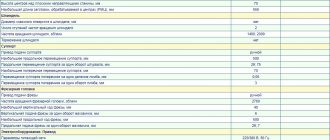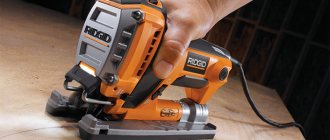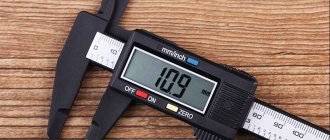A voltmeter is an electrical measuring instrument that is designed to measure the electrical voltage at the poles of a current source or at some part of the electrical circuit. This value is given in units called volts, hence the name of the device - “Voltmeter”. In practice, electrical voltage values are measured in various ranges, from microvolts (µV) to megavolts (MV).
These devices are commercially available in both analog and digital versions.
Many voltmeters are very similar in appearance to ammeters. To distinguish a voltmeter from other electrical measuring instruments, the letter V is placed on its scale. On diagrams, a voltmeter is depicted as a circle with the letter V inside (see Figure 1).
Figure 1. Electrical circuit with voltmeter
Types of voltmeters
If we talk about the types of voltmeters, they are divided into:
- Voltage meters (DC) marked B2. Widely used as a wiring test device for automobiles and other equipment;
- Voltage meters (alternating) are marked as B3. As a converter of variable parameters into constant indicators with amplification of the output signal;
- Pulse sensitivity devices are designated B4 and are used when taking characteristics obtained as a result of short voltage pulses. With their help, interference is detected, that is, poorly made contacts. They are mainly used when it is necessary to test electrical automotive wiring, as well as conventional microcircuits, along with others;
- B5 with phase distribution with two sensitivity zones, when you can take two indicators at once. With their help, measurements are carried out where the first harmonic component is present. In everyday life, such equipment is practically not used;
- Selective frequency search (B6) with significant dimensions, reminiscent in design of radio signal receivers;
General value or universal, allowing you to take readings in any type of circuit (B7). Shunts are included in the package to make the connection as secure as possible.
What is the maximum voltage that should be in the network?
In a standard apartment building, the voltage standard is 220V. The normal network frequency is 50 Hz. There is a permissible deviation of 5%, that is, from 209 to 231V, and there are also maximum permissible standards of 10% (198 - 242V).
Interesting materials:
What is the difference between durum pasta? How are boys and girls parrots different? What is the difference between manti and khinkali Buuzy? What is the difference between water-based and alcohol-based markers? How are oil pens different from regular pens? What is the difference between matte photographs and glossy photographs? How are medical masks different from hygienic ones? What is the difference between copper-graphite brushes and graphite brushes? How do mammals differ from other animals, class 2? How do moral standards differ from customs and legal laws?
Appearance of the voltmeter
There are three types, thanks to which you can distinguish the parameters of voltmeters:
- Providing portability, characterized by autonomous operation with small size and weight, as well as an easy-to-carry body part. To take characteristics, they are usually equipped with either “crocodile clips” or clothespins - these are two metal contacts;
- The stationary plan weighs significantly more due to the presence of increased sensitivity. Their installation is carried out in places of complex equipment; here they are necessary to be able to constantly monitor the general condition of both refrigeration and heating units, along with the air conditioning system. In cases where the power comes from a generator, their presence is simply necessary so that in the event of a failure in a specific section of the circuit, the fault can be immediately detected and eliminated;
- For installation in shields, devices are used that are average in weight and size between stationary and portable models. This option is considered justified and appropriate
Description of the operating principle of a voltmeter
In terms of their functionality, voltmeters can be either mechanical or electronic, depending on the method of making measurements:
- Electromechanical models have a pointer mounted on a frame, which is mounted on an axis (permanent magnet). The applied voltage, which creates an electric and magnetic field, deflects the pointer with the frame, pointing to the scale mark.
- The sensitivity of the devices is different, expressed by the coefficient between the reading on the scale and the actual voltage. Pointer vibrations are eliminated using an aluminum induction damper.
- Counterweights prevent gravity from affecting the needle readings. All parts are steel and will not wear off, and the rods are polished to reduce friction;
Electronic models are either analog or with electronic “filling”.
- The former are very similar in appearance to conventional mechanical ones; they are also available with a built-in arrow.
- The built-in converter system does not allow the needle to oscillate randomly, ensuring measurement accuracy.
- The latter are equipped with an internal controller and a display for displaying signals.
- Such devices are characterized not only by greater measurement accuracy, but also by light weight, compact dimensions, along with reliability.
- Obtaining more accurate measurement results directly depends on what class of transducer is installed in a particular case.
The display shows the already translated signal in the form of a digital code from the received voltage parameters.
Homemade devices
How to make a voltmeter with your own hands, what it is for, how it works, how a voltmeter is connected, how to use a voltmeter - this is an incomplete list of questions that beginner radio amateurs and ordinary users have. The principle of operation of a voltmeter or the principle of operation of a voltmeter was discussed earlier when considering its different types and types.
At very little cost you can make it yourself . Its main part is a dial gauge. The scale has a voltage designation - the Latin letter “V”. Of course, it is advisable to have a voltmeter with the required measuring range. On the left side of the scale there should be o, and on the right there should be a number that shows the maximum voltage value measured by this device.
How to use and connect a voltmeter
In order for the obtained data to be as accurate as possible, the device must always be connected in parallel to the area where measurements are planned using terminals or clamps for special purposes.
High voltage voltage is not intended to be measured by weak voltmeters, the parameters of which are in no way designed for this.
- The devices have different measurement ranges, ranging from millivolts to kilovolts.
- The sensitivity of microvoltmeters allows you to measure millionths of a volt.
- The range of the device is taken into account primarily so as not to cause a short circuit.
In addition, devices designed for direct current are absolutely not suitable for measuring alternating current values. The use of universal models is carried out only after selecting the appropriate measurement mode.
Some tips for beginners
These tips will help beginners who have to use a voltmeter in their work for the first time. There are few of them:
- Connecting a voltmeter.
- Maintain polarity.
The polarity of the connected voltmeter test leads must correspond to the polarity of the voltage indicated on the diagram.
The voltmeter should always be connected in parallel to the circuit being measured. This differs from an ammeter, which is connected to a gap. For a full-wave AC rectification circuit, the polarity of the test leads can be ignored. The probes must be held so that your hands touch only their isolated part.
Originally posted 2018-03-28 15:34:30.
Characteristics of voltmeters
All models, without exception, have common criteria by which performance is assessed. This does not depend on the principle of operation, nor on the purpose, nor on the method of its execution.
Measurement accuracy is the first parameter that you need to pay attention to before purchasing or using it.
The greater the resistance inside the voltmeter, the less influence it has on the measurement process, thereby reducing the error. In this case, its effect on the electrical circuit is minimal.
Principle of operation
Electromechanical type meters were the first to be created. They operate using the magnetoelectric principle. A permanent magnet is fixedly fixed, and a steel core is installed between its poles. This structural element is installed in such a way that a constant electromagnetic field can be formed in the annular air gap.
A frame made of aluminum is installed in the gap on the axle shafts. She is able to move freely. There is also a spool of thin wire on the frame. The indicator arrow of the device is attached to the frame using springs. As soon as an electric current begins to pass through the device, an electromagnetic field appears in the winding. The frame interacts with it and deflects along with the arrow to a distance corresponding to the voltage value.
The design of the meter also contains an induction damper - an aluminum plate mounted on a frame with an arrow. In accordance with Lenz's rule, eddy currents arising in the damper interact with the magnetic field that generated them and slow down the oscillations of the device pointer. To achieve the required measurement accuracy, the device must not be exposed to gravity during operation.
To solve this problem, the moving part of the meter is equipped with a system of weights moving on rods. In addition, to ensure accurate measurements, it is necessary to reduce the friction force of the steel tips . This is achieved through the use of special wear-resistant steels. Parts made from them are polished.
Before starting the measurement, the user needs to set the indicator arrow to the zero position.
For this purpose, the design of the device includes a special adjustment screw connected to a spring. This is a classic design, but today there are devices containing magnets of different shapes. Moreover, in some designs the magnet is movable.









